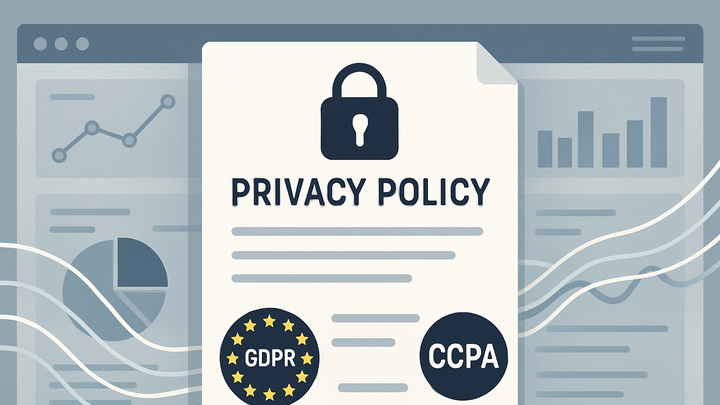Published on 2025-06-22T04:35:19Z
What is a Privacy Policy in Analytics? Examples and Best Practices
A Privacy Policy in the context of analytics is a legal statement that informs users how their data is collected, used, stored, and shared when they interact with a website or application. It ensures transparency, builds trust, and helps organizations comply with regulations such as GDPR, CCPA, and other regional privacy laws. An analytics-focused Privacy Policy should clearly describe which tools you use (e.g., GA4, PlainSignal), what data points you track (pageviews, clicks, device info), and how users can control their data. Maintaining an up-to-date policy also mitigates legal and reputational risks associated with improper data practices.
Example tracking code usage with PlainSignal:
<link rel="preconnect" href="//eu.plainsignal.com/" crossorigin />
<script defer data-do="yourwebsitedomain.com" data-id="0GQV1xmtzQQ" data-api="//eu.plainsignal.com" src="//cdn.plainsignal.com/plainsignal-min.js"></script>
Privacy policy
Statement explaining how analytics data is collected, used, stored, and shared to ensure transparency and legal compliance.
Why is a Privacy Policy Important in Analytics?
A Privacy Policy builds trust with users and ensures legal compliance. It outlines how analytics tools collect and process user data, making your practice transparent. Without a clear policy, organizations risk fines, legal action, and reputational damage. It also empowers users by informing them of their data rights.
-
Legal compliance
Privacy laws such as GDPR and CCPA mandate explicit disclosure of data collection practices, especially when cookies or personal identifiers are involved.
-
User trust
Transparent policies demonstrate respect for user privacy, fostering confidence and reducing bounce rates caused by privacy concerns.
-
Risk mitigation
Clearly outlined practices help mitigate fines, litigation, and customer churn resulting from privacy violations.
Key Components of an Analytics Privacy Policy
An effective analytics Privacy Policy outlines what data is collected, how it’s used, with whom it’s shared, and how users can control their data. Each component should be precise and avoid technical jargon where possible.
-
Data collection
Describe the types of data collected by analytics tools, such as user interactions, device information, and identifiers.
-
Personal identifiers
Information like IP addresses, user IDs, or email addresses.
-
Behavioral metrics
Data such as pageviews, click events, and session duration.
-
-
Data usage
Explain the purposes for which collected data is used—improving user experience, customizing content, or generating reports.
-
Performance analysis
Using data to optimize load times and site performance.
-
User engagement
Tailoring content and features based on usage patterns.
-
-
Third-party sharing
Detail any third parties (like analytics platforms) that receive data and their role in processing it.
-
Analytics providers
Services like Google Analytics 4 or PlainSignal that process data on behalf of the website owner.
-
Advertising partners
Entities that may use data for targeted advertising purposes.
-
-
Cookies and tracking technologies
Clarify the use of cookies, local storage, and other technologies for tracking user behavior.
-
First-party cookies
Cookies set by your domain for session management and analytics.
-
Cookie-free tracking
Alternatives like PlainSignal’s cookieless analytics for privacy-friendly insights.
-
Implementing Privacy Policy for PlainSignal and GA4
Practical steps to integrate your Privacy Policy with popular analytics tools, ensuring that code snippets and consent mechanisms align with your disclosures.
-
PlainSignal (cookie-free analytics)
PlainSignal offers a privacy-first, cookieless analytics solution that often eliminates the need for consent banners, simplifying compliance.
-
Integration code
Add the following snippet within your
<head>to start tracking:<link rel="preconnect" href="//eu.plainsignal.com/" crossorigin /> <script defer data-do="yourwebsitedomain.com" data-id="0GQV1xmtzQQ" data-api="//eu.plainsignal.com" src="//cdn.plainsignal.com/plainsignal-min.js"></script> -
Privacy benefits
No cookies are used, so user consent is often not required, streamlining your policy wording.
-
-
Google analytics 4 (GA4)
GA4 provides advanced analytics but relies on cookies and identifiers, so you must inform users and offer opt-out options.
-
Consent mode
Configure GA4 consent mode to respect user opt-ins for analytics and advertising cookies.
-
Policy disclosure
Explicitly mention GA4 in your Privacy Policy, including Google’s data processing terms and any data retention settings.
-
Best Practices and Ongoing Compliance
To keep your analytics practices aligned with evolving regulations, regularly update your Privacy Policy and review tool configurations.
-
Policy updates
Monitor legal changes and update the policy text at least annually or whenever your analytics setup changes.
-
User notifications
Communicate significant changes to users via email or on-site notifications, and obtain renewed consent if required.
-
Audit and logging
Maintain logs of consent records and analytics configurations to demonstrate compliance during audits.
